01 Vertical Village
School residence under urban density
PROJECT BRIEF
Located in downtown Toronto, this project proposes a school residence for the University of Toronto, St. George Campus students. Besides the residential capability, the site also needs to provide communal services for its dwellers: gyms, study rooms, workshops, rostrum, lounge, gallery, indoor and outdoor green spaces, and cafeteria are embedded into the building systems.
Driven from the study of Harbord Village, a typical Canadian downtown community with singlefamily houses, whose public and communal services surround the residential buildings, the new school residence “Vertical Village” is a response to the traditional nature-intimate living style on a densified land. Instead of spreading horizontally on the ground, the 9-floor school residence seeks vertical growth, and a reverse relationship between the residential units and semi-public programs is created. All private rooms in the Vertical Village are located on the edges of every floor, south and east the most, in making sure of the access of sunlighting, while communal services are the core and shaping a central gathering circulation to the architecture.

Diversity is given to all dwellers by inserting various programs with flexible spatial interactions. Six unit types promote individuality and creativity in living spaces in both private enclosures and semi-private balconies. The private access to light and the sky is crucial in illustrating the primitive village lifestyle.

Yuhan Zhang // yvonneyuhan.zhang@mail.utoronto.ca 1
Conceptual Diagram - Vertical Village Site Map - Downtown Toronto - Harbord Village | Univeristy of Toronto St. George Campus
Individual | Professor Dina Sarhane | Spring 2021 | Toronto, Canada
SITE SEGREGATION AND BUILDING DENSITY TEST



Nakagin Capsule Tower is a metabolic strategy for densified Tokyo city. Through its 2.5mx4m capsules, the tower highlights the basic elements for living: a bed to rest; a microwave for heating the food from convenience stores; a washroom; and a window to access sunlight.



South-facing windows are placed mostly among the four-sided facade of the tower, promoting sunlight in individual capsules.
While the window unfolds city’s skyline to the residence, a diverse lifestyle could be revealed from the circle openings.
The capsules aggregate by pairs along the two central vertical cores. Placed in different levels, the capsules are unified by elevator. It encourages the interaction between dwellers by extending the inner paths.

Yuhan Zhang // yvonneyuhan.zhang@mail.utoronto.ca 2 VERTICAL CIRCULATION PLAN PERSPECTIVE INTERIOR UNIT DIAGRAM BUILDING ENVELOPE ILLUSTRATION CAPSULE SUNLIGHT STUDIES DIAGRAM PRECEDENT STUDIES | NAKAGIN CAPSULE TOWER AGGREGATION 1 ISOMETRIC DIAGRAM AGGREGATION 2 ISOMETRIC DIAGRAM
01

Yuhan Zhang // yvonneyuhan.zhang@mail.utoronto.ca 3 SITE PLAN NEW AGGREGATION INTEGRATED WITH EXISTING SITE CONTEXT 01
TYPICAL FLOOR PLAN







TYPES
I-SHAPE UNITS
One Bedroom / Two Bedrooms

L-SHAPE UNITS Four Bedrooms
T-SHAPE UNITS
Three Bedrooms / Four Bedrooms

Yuhan Zhang // yvonneyuhan.zhang@mail.utoronto.ca 4
TYPICAL UNITS SEMI-PRIVATE COMMONS UNIT
INTERIOR RENDERING 01
SEMI-PUBLIC PROGRAMS
CAFETERIA / RESTAURANT VERTICAL CIRCULATION SHAFT

WORKSHOP
LEARNING STAIRS
PRIVATE BALCONY GALLERY
SEMI-PUBLIC BALCONY
ROOF GARDEN
GARAGE ROSTRUM
LAUNDRY ROOM COURTYARD STUDY ROOM VERTICAL GARDEN
Yuhan Zhang // yvonneyuhan.zhang@mail.utoronto.ca 5 SECTIONAL PERSPECTIVE UNIT AGGREGATIONS
AND
01
The Sky Garden is a three-stories height vertical green space. It creates a semi-public place that invites all residences to enjoy the fresh air, green plants, and sunlight. The garden supplies green spaces requirement around the site, promoting a healthy lifestyle.
Semi-public programs are embedded in the core of the building. By varying height and spliting levels, the spaces between each program are opened and interact. The spatial flexibility actives the creativity of the dwellers.
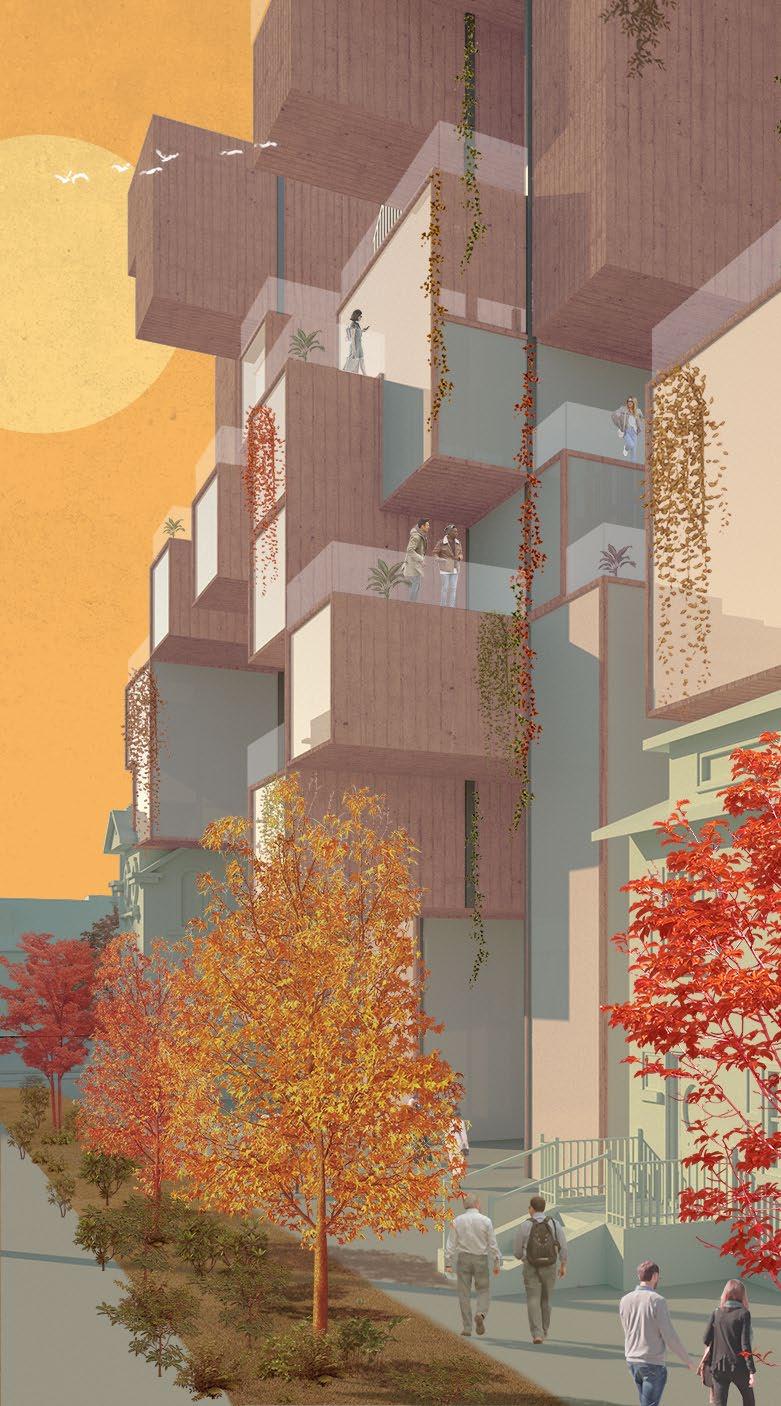


Sitting on top of three heritage houses, the new school residence is well integrated with existing site and actively engages with the community.
The large private and semi-private balcony could be closed up by the retracting walls. Sunrooms will be temporarily built up for activating the semi-exterior space in snowy weather.
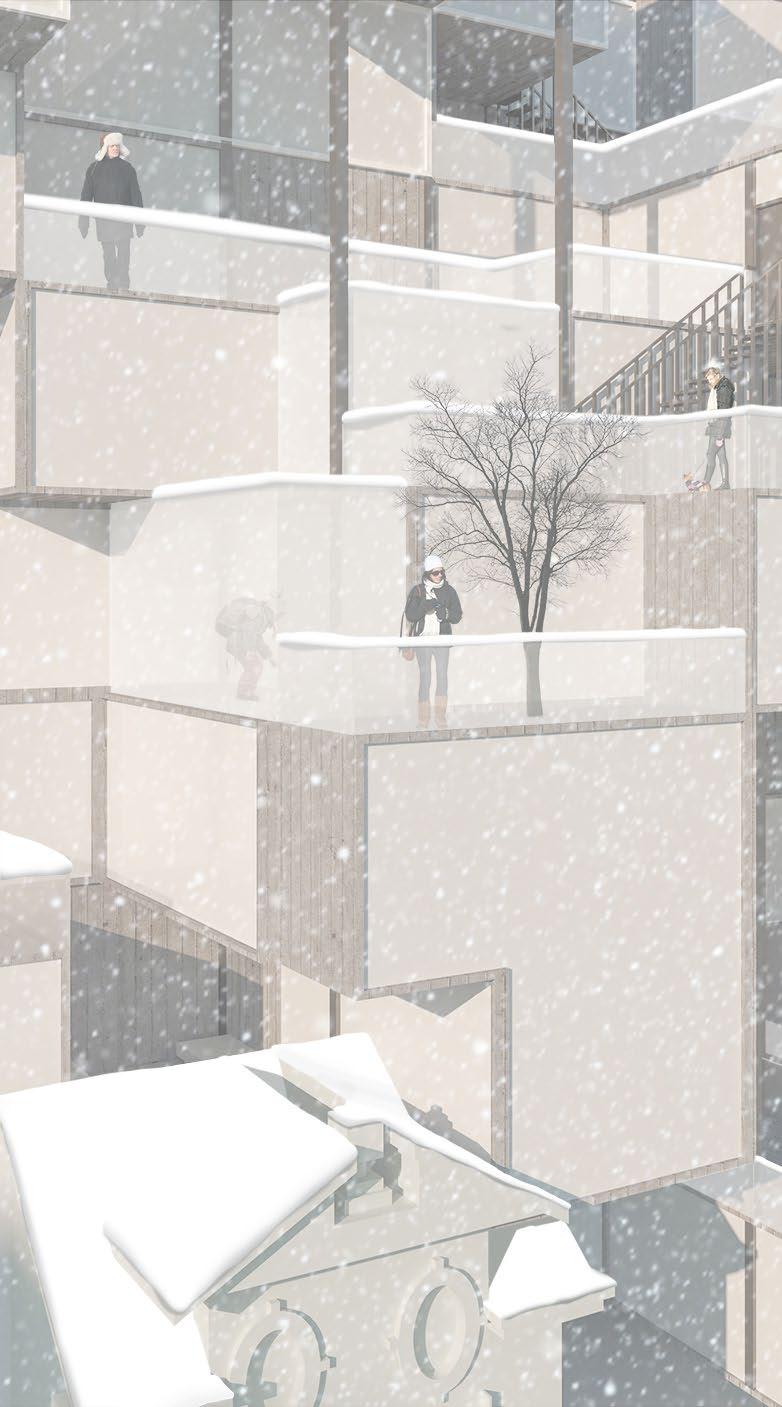
Yuhan Zhang // yvonneyuhan.zhang@mail.utoronto.ca 6 ADAPTIVE DESIGN IN FOUR SEASONS
SPRING
COLLAGE / RENDERINGS
SUMMER WINTER FALL
01
The design of the school residence actively responds to its existing site. Building directly on top of three historical preserved houses creates an intimate relationship between the traditional brick and the contemporary glass and concrete material. It demonstrates a solution for both conservation and development. Instead of only preserving the street facade, the interior of the houses is reinforced and revived with new public programs for the vertical community.
Instead of spreading horizontally, the building seeks its growth vertically with rooms located on the edges of each floor and semipublic services in the center. This reversion of the public and private relationships creates more community engagement and offers more spatial possibilities for diverse groups. Dwellers in different directions have equal opportunities heading towards the central communal programs.
Modular aggregation of the units rejects typical stacking in floor plans, which promotes outdoor pocket spaces for direct access to air, daylight and widespread vertical green. Prefabricated blocks reduce the on-site construction time in cold weather. The school residence endeavours to harmonize nature and humans and balance its spatial flexibility and building efficiency. Carbon emission is also lowered down through a contractable building footprint.

Yuhan Zhang // yvonneyuhan.zhang@mail.utoronto.ca 7
COLLAGE / RENDERINGS 01
A house for two inhabitants on ravine land
Individual | Professor Petros Babasikas, Alejandro Lopez | Fall 2020 | Toronto, Canada
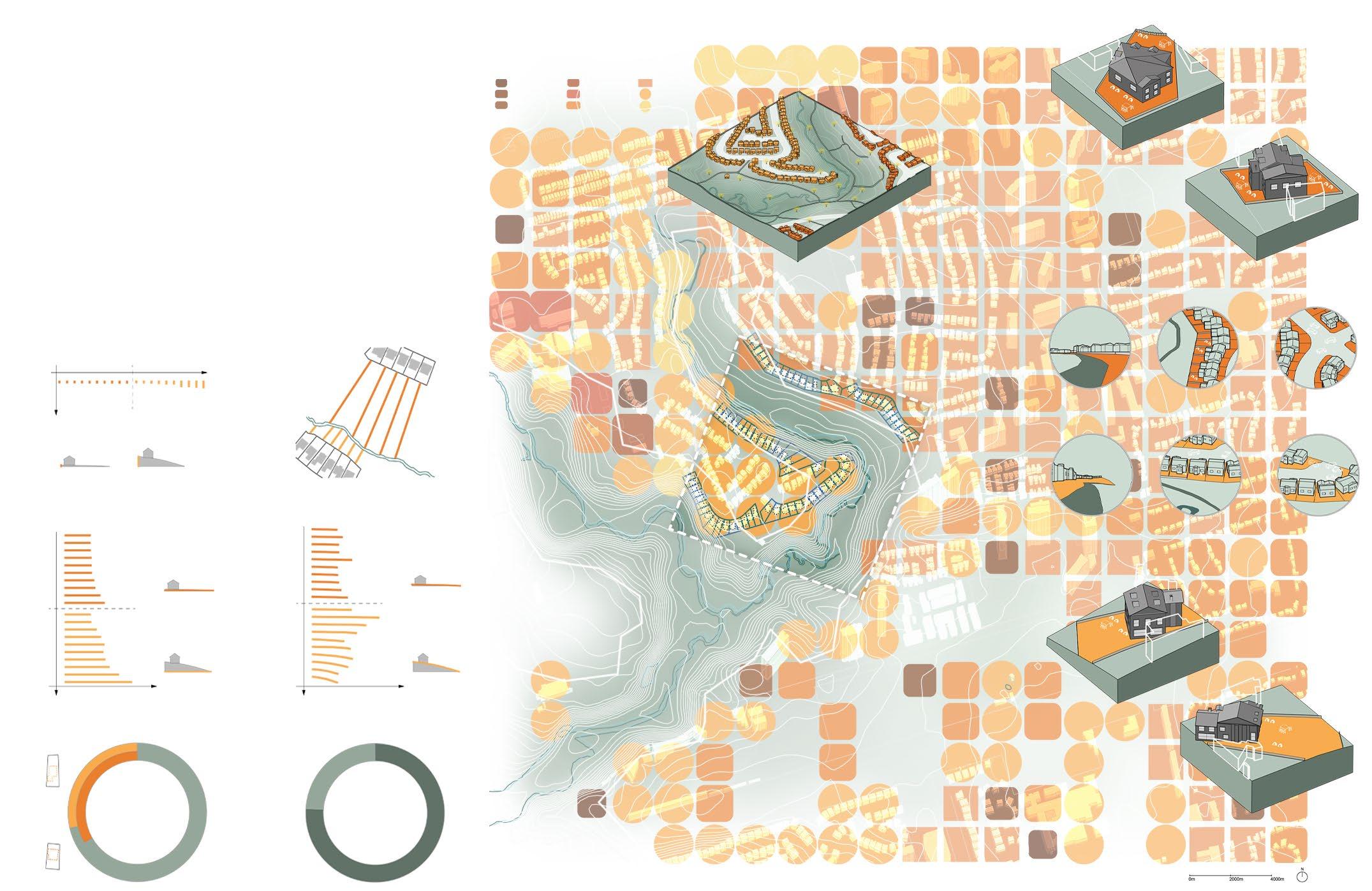
PROJECT BRIEF
The House for Two Inhabitants is designed for a couple who married for a long time. One is a writer who needs a library and a studio with large windows for his works. The other one is an artist who needs an open studio and a gallery for exhibition.
Inspired by the Glass House by Lina Bo Bardi, the house uses courtyards to communicate between interior and exterior, artificiality and nature. Design of the house also focuses on: raising ground for reducing train noises, reducing the snow load, and gaining passive heating by titled roof and glass panels. The glazing glasses blurs the boundary between interior and exterior.
Built on Toronto’s ravine system, the house actively responds to its ecological environment and land. By analyzing existing ravine strategies, the House for Two Inhabitants grounded itself into the land instead of separating from it.
Yuhan Zhang // yvonneyuhan.zhang@mail.utoronto.ca
8
152.7% 52.96% 6% 4.77% 138.46% RAVINE SYSTEM
HOUSING
DROP ELEVATION DISTANCE TO RIVER DROP ELEVATION RATIO RATIO IN RAVINE DROP SLOPE from Front Door to Back Yard from Front Door to Back Yard Avg. House / Yard Area 737066m from Front Door to Back Yard 1960 2020 2020 Avg. 0.93m
Avg. 37.2m Avg.
Avg. 39.4m 33.37% 24.08% 75.92% 28.6% House 1960 Private Property Public Property House 2020 Yard 177466m 559600m Avg. 3.41° INCR. 1.42m DEC. 56.26m INCR. 2.24m INCR.
Avg. 2.35m
Drop(m) 2020 1960 1960 Depth(m) Depth(m) BACK YARD SLOP BACK YARD SLOP TRAIL TO RAVINE TRAIL TO RAVINE ROAD / INTERSECTION ROAD / DEAD END 02
TORONTO RAVINE SYSTEM STUDIES
TORONTO HOUSING 1960
2020
Avg. 106.23m
1.43°
1.98°
Avg. 49.97m
Co-Living with Greenery
1860 1920 1980 1880
1940 2000 1900 1960 2020 YEAR LAND USED FOR HOUSEING
STUDIES
As the Rathnelly Community, communities on the slope generate their building and living strategies. Stairs leading dwellers from sidewalks to their own doors are as crucial as the door itself. Steep lands are turned into play yards, parks and conservation areas. Cycling is much more difficult in the community. A pumping system is embedded in dealing with the drop of height.
The city of Toronto is landed on its ravine system, where the built environment and natural system are blending together for biodiversity, environmental significance, and local ecological and recreation opportunities.

HIGH LEVEL PUMPING STATION PRIVATE STAIRS RATHNELLY COMMUNITY
SITE MAP
BB: SECTIONAL DRAWING - Rathnelly Community Living on Ravine Land

AA: SECTIONAL DRAWING - Palying Yard on Slopping Land


9
Yuhan Zhang // yvonneyuhan.zhang@mail.utoronto.ca
COLLAGE - Existing Site Context
RATHNELLY COMMUNITY TOPOGRAPHY
RAILWAY
CYCLING ON SLOP
PLAY YARDS 02
SYSTEM
RAVINE PARKS
The Glass House is built on the edge of the Mata Atlantica — the original rain forest in São Paulo. Surrounded by nature, the Glass House mainly uses glass and concrete to frame different forest views for the house.

Bo Bardi dissects the house into four vertical strips — the living room, domestic area (bedroom and kitchen), courtyard, and staff area. Through the separation, she arranges various needs in privacy and publicity and their corresponding views to nature.

PLAN

Bo Bardi shows an uncompromising stand in forming the flat and free plan. Lifting half of the structure makes the house incompatible with its surrounding environment.

ELEVATION
Yuhan Zhang // yvonneyuhan.zhang@mail.utoronto.ca PERSPECTIVE DRAWING PRECEDENT STUDIES OF GLASS HOUSE BY LINA BO BARDI
02
A physical model is made to test the melting greenery of the Glass House. Layered by plexiglass with laser-cutting scratch, the house is sliced into a series of sections, creating gaps for the interaction with watercolor. The material selection of Plexi echos with the transparency of the house, speaking for its unstoppable view to the outside. The watercolor here, represents the natural environment around the Glass House: Green color illustrates all the leaves in the rainforest, and purple stands for the flower around. A rich of visual stimulation is generated.

A symbiosis system is created when dipping both the Plexi model and pigments into the water. The water, as a medium, slows the collusion between the greenery and the artificial object. In analyzing different moments of the spreading pigments, a rich of attitudes towards their encounter could be identified by the pigment’s concentration: when the color first into the system, it collides to the house, while later it becomes more and more gentle and intimate in those section slides. The organic pattern of the spreading watercolor also speaks for the dynamic of the ecological system through its uncontrollable gestures. This experiment could also reveal a series of possibilities of engaging with the green.


Yuhan Zhang // yvonneyuhan.zhang@mail.utoronto.ca 11 PHYSICAL MODEL RENDERING FILM STILL GREENERY EMBRACEMENT
02
The train’s noise on the north of the site is reduced by raising the ground and planting trees. The designed landscape builds up a barrier between the train and the house.

Built in Toronto, a northern city, the large tilted roof will help reduce the snow load. Southern lights are encouraged for passive heating.
The house with floor-toceiling glass panels and a courtyard promotes a positive engagement with the green. The side yard could be used for both private family gatherings and public outdoor galley.


Yuhan Zhang // yvonneyuhan.zhang@mail.utoronto.ca 12
EXTERIOR RENDERING
PLAN - Ground Floor
PLAN - Second Floor
INTERIOR PROGRAMS 02
MASTER BEDROOM
GUEST BEDROOM PRIVATE LOUNGE LIBRARY / STUDIO RAISED GROUND

Yuhan Zhang // yvonneyuhan.zhang@mail.utoronto.ca 13 SECTIONAL PERSPECTIVE
LIVING ROOM / GALLERY COURTYARD KITCHEN DINNING ROOM WORKSHOP / BEDROOM STUDIO
TRAIN TRACK PROGRAM ANALYSIS 02




Yuhan Zhang // yvonneyuhan.zhang@mail.utoronto.ca 14
COURTYARD | MASTER BEDROOM | BALCONY BEDROOM | LIBRARY | BACKYARD
GREENERY EMBRACEMENT COLLAGE | LINE DRAWING 02
KITCHEN | COURTYARD | LIVING ROOM BACKYARD | GALLERY | COURTYARD
Spatial flexibility is given to the single-family house, where the living room and side yard could fulfill both personal and public needs. According to the artist’s requirement, the living room could be turned into an exhibition center for installing her work during special time; the side yard could also function as an outdoor gallery where largescale installation could be placed. The front of the house is designed to be opened to the community and also embraces the greenery around through the large floor-to-ceiling glass panels. Creativity is promoted by giving less restriction to the structure. An intimacy between humans and nature is highlighted as the need of the householders.

During the wintertime, the house is closed up for the family. Highlighted above, the back of the house functions as the workshop space for both the writer and the artist. The ground floor is equipped with an open studio and an open bedroom, where the dweller’s spatial flexibility is largely given to. Located on the first floor also help with moving installations created by the artist. The second floor is programmed with a library for the writer. The height of the working space also provides him with a sightseeing view which promotes his creative thinking. Ground raising and tree planting create a natural barrier between the train and the house. The south-facing large panel of glasses provides adequate passive heating in the cold winter. Dwellers’ wellbeing is achieved by embracing its site context, both mentally and physically.
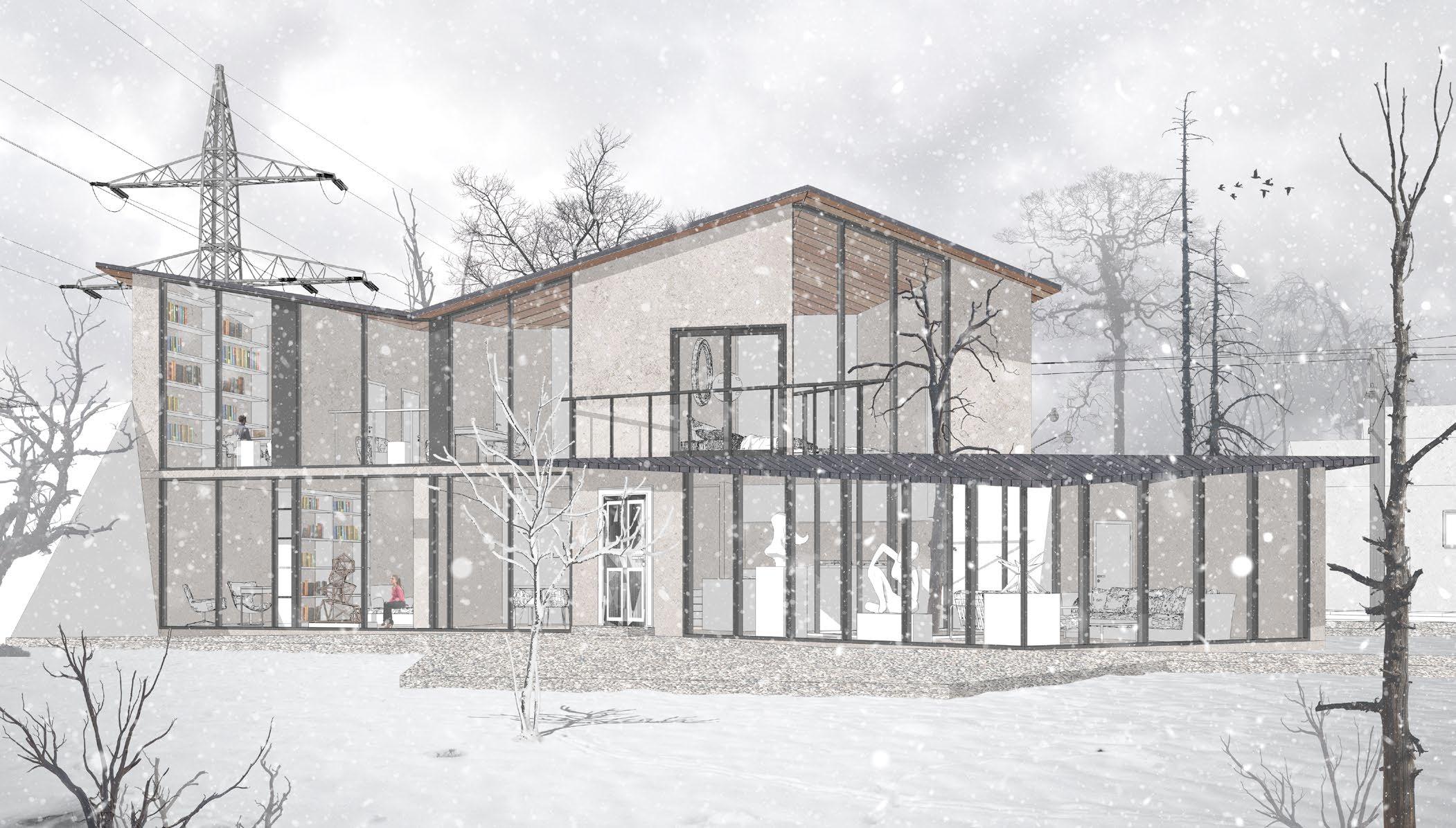
Yuhan Zhang // yvonneyuhan.zhang@mail.utoronto.ca 15 COLLAGE | RENDERING ADAPTIVE DESIGN BY EVENTS
02
Bauhaus campus masterplan with movable structures

Collaborated with Z. Li and H. Wu | Competition | Spring 2021 | Dessau, Germany Contribution | Design concept, 3D modeling, Isometric Drawing
PROJECT BRIEF
Contemporary university campuses should work with new technologies to create flexible architecture and encourage students to be innovative, providing unlimited possibilities for new things.
The original Bauhaus campus was decentralized. Taking inspiration from the technology development in the 20th century, Gropius placed stairs beside glass panels—so that people had a different view towards the outside as they took the stairs step by step. Our new campus has taken on a similar decentralization approach but amended it to promote the latest perception of transformative architecture and encourage students to think more adaptively to social changes.
The campus consists of multi-function: as a public exhibition space, a school and a residence.
In response to the railway beside the site, we include track systems into the campus to allow maximum movability of large architectural modules.
Apart from the building blocks, the interior space is also designed to be transformable. There are various structural systems used for horizontal and vertical movement of walls, floor slabs and ceilings.
A special treatment to the landscape is made to generate a unique and interesting experience through the campus. The centre courtyard is sunken to create an inclusive fabric of gathering space that extends into public, private, semi-public and semiprivate realms.
Although Gropius’ principles were from more than a century ago, they never ceased to inspire creative designs. The new Bauhaus campus is designed to form a creative centre in Dessau. With its connection to the nearby Bauhaus museum, the Anhaltisches Theatre and the AlterRaucherturm, it will become a site of architectural and urban innovation.
Yuhan Zhang // yvonneyuhan.zhang@mail.utoronto.ca 16
03
Track
Along the
SITE MAP - Individual Drawing

Yuhan Zhang // yvonneyuhan.zhang@mail.utoronto.ca 17 HIGHLINE OUTDOOR GALLERY EVENT LAWN EXHIBITION CENTER GYM | CONCERT HALL STUDIO | WORKSHOP RESIDENCE AXONOMETRIC DIAGRAM - Individual Drawing 03

Yuhan Zhang // yvonneyuhan.zhang@mail.utoronto.ca 18 MOVEABLE STRUCTURE DIAGRAM CONCEPT DIAGRAM - Individual Drawing 03
Arbitrary Regularity
Shaping edges in architectural spaces

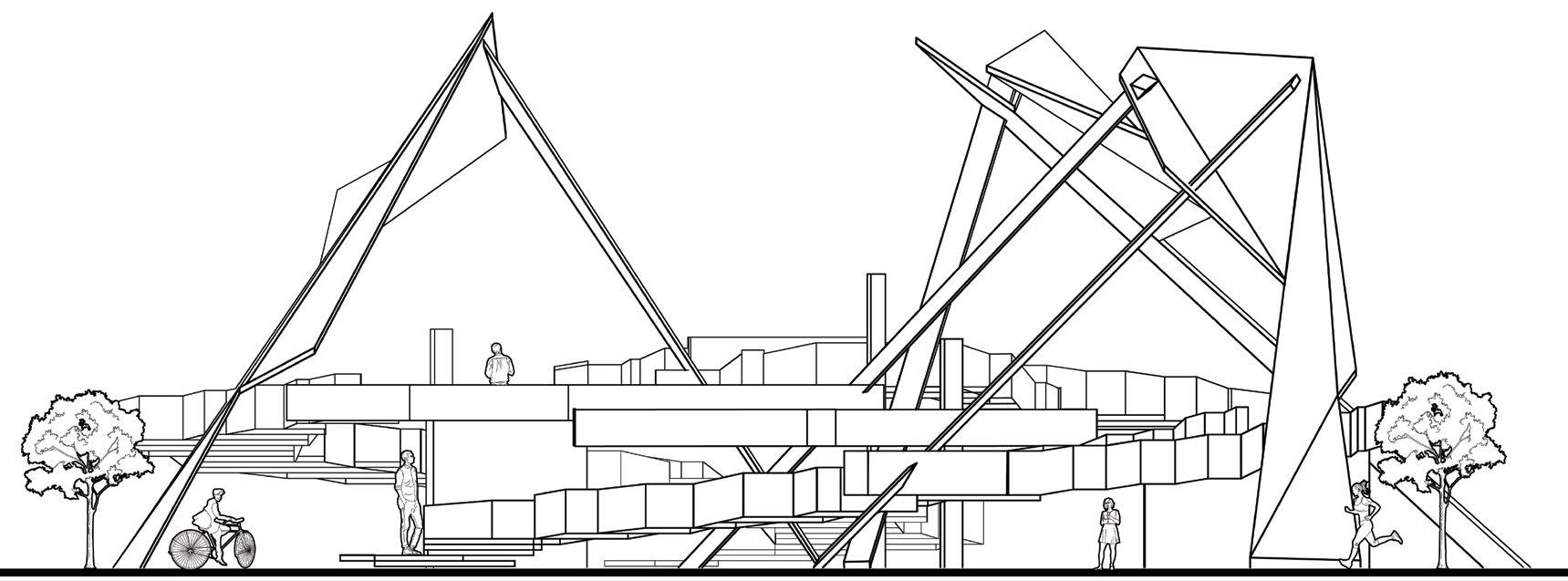

PROJECT BRIEF
The Canadian Artist David Altmejd inspires the series of projects. As he is interested in transforming daily objects, such as human bodies and the organic environment, through everyday materials, such as synthetic hair and mirrors, Altmejd gives familiar entities new life. The design starts with the Art Pavilion for David Altmejd in Downtown Toronto, to the Student Commons located in the University of Toronto St. George Campus. It is a spatical experiment by polygonizing our human scale spaces.
SITE ANALYSIS

I. ART PAVILION
VARIATION I
The plan is generated from a geometric shape of a human head. Its “roof-wall” is inspired by the shape of surrounding townhouses. The two-stories structure provides chances for viewing artworks from every angle.
VARIATION II
The mirror attached on the unique“roof-wall” structure is applied in reflecting the neighborhood. Two sets of stairs are designed to form a smooth circulation.
VARIATION III
Openings are curved for engaging more views from the neighborhood. Long glass boxes are designed integrated with the pavilion in installing the artworks.
HYBIRD RENDERING
The project aims to design an art pavilion for artist David Altmejd, with a focus on his works of heads. As Altmejd takes the shape of familiar objects - the heads and makes them unfamiliar, the formal design of the pavilion also takes the elements in residential houses around the site - the Kensington Market and makes it distinct from its surrounding through building materials.



The Kensington Market locates in the center of an old Jewish community in the city of Toronto. The market is one of the most popular downtown places, which attracts neighbors and travellers for entertaining: restaurants, hand-craft shops, galleries. It embraces multi-culture. The place has sophisticated existing networkings, where a large number of art-lover could be found.

Yuhan Zhang // yvonneyuhan.zhang@mail.utoronto.ca 19
SITE PLAN - Existing Networking 5km Around 1:5000 SITE MAP - Noli Map 1:500
Individual | Professor Professor Jennifer Davis, Anne Ma | Spring 2019 - Spring 2020 | Toronto Canada
04
ELEVATION
Glass Panel Mirror Stand Exhibited Artworks Roof-Wall Kensington Market
SECTION
PLANE | Horizontal “Surface”
VARIATION I.
VARIATION I.

VARIATION II.
VARIATION II.
VARIATION III.
This studio focuses on creating architectural spaces in given dimensions. The dynamic and unique geometric shapes are generated within its regulation.

The first step explores the possibility of geometrical and polygonized spaces, starting from vertical strips. Through the manipulation of threads, the rooms are folded out through the volume of the “walls.” A twostories structure is created.



The second part exams the possibility through the horizontal “planes,” by its geometric simulation of organic mountain-like structure. The potential of polygonizing a space expand.

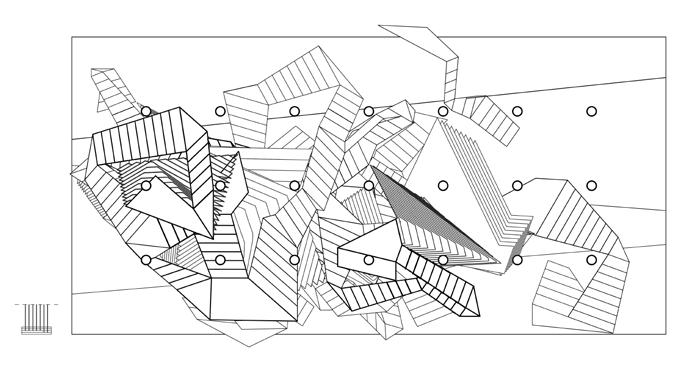






What kinds of space can we polygonize?
The structure is formed by two elements - the “path” and the “block.” The “path” is the stairs that visitors could freely walk through and across the space, while the “block” acts as the giant stones that block but also create the sight. The space is activated by these two elements.

Installed separately by three elements: stairs, blocks and structure, the physical model discovers their intimate relationships and unique views.







Yuhan Zhang // yvonneyuhan.zhang@mail.utoronto.ca 20
SOL LEWITT “THREAD” VERTICAL STRETCH SPACE ARRANGEMENT
“PATH” “BLOCK”
II. POLYGONIZE THE SPACE
VARIATION III. LINE | Vertical “Wall”
SECTION
PHOTO - Physical Model PHOTO - Physical Model PHOTO - Physical Model
PLAN ISOMETRIC DIAGRAM ISOMETRIC DIAGRAM
ELEVATION - Right ELEVATION - Front
04








Yuhan Zhang // yvonneyuhan.zhang@mail.utoronto.ca 21 VOLUME - “Cube” | STUDENT COMMONS SPATIAL COMPLEXITY VARIATION I. VARIATION II. VARIATION III. A Cube Rubik’s Cube Tetris Cube Floor 1 Plan I. Floor 2 Plan I. Floor 3 Plan I. Floor 4 Plan I. Find Edges Floor 1 Plan II. Floor 2 Plan II. Floor 3 Plan II. Floor 4 Plan II. Roof Plan I. Interior Separation Floor 1 Plan III. Floor 2 Plan III. Floor 3 Plan III. Floor 4 Plan III. Roof Plan II.
PLANS BASEMENT GROUND SECOND FLOOR THIRD FLOOR SECTIONAL PERSPECTIVE SECTION - Left SECTION - Front 04
FLOOR
Through the experiments in both vertical and horizontal planes, the cube is now dissected into polygonal spaces, providing possibilities in experiencing its volume

Why we polygonize a space?
Enriching the dimension, we live and enjoy.

Yuhan Zhang // yvonneyuhan.zhang@mail.utoronto.ca 22 Rendering
04
Computational
PROJECT BRIEF
The project explores the potential in computational design by discussing the physical world and the digital realm through software, such as grasshopper, blender, agisoft and twinmotion. As a motif of our project, the Gummy Bear links the collective childhood memories with unfamiliar random programming structures.







The project starts with Stan Allen’s idea that in the field configurations, internal interaction and relationship between individual parts outweigh the overall shape. It explores this phenomenon in its most abstract form through the use of the computer graphics software, Blender. Based on the local conditions of a flock. Additional behavior rules and a moving attractor point to a mass of gummy bears are discovered to explore the formal potentials of forces and field phenomena. The established conditions enable the overall form to respond and remain intact despite changing forces experienced by individual particles.
Second phase of the project explores Thomas Vanoost’s idea of an inherently chaotic and unstable reality through scanning and modeling gummy bears at different resolutions. Gummy bears that were scanned and modeled at a lower resolution more closely resemble bricks and form a denser and more stable structure. On the other hand, more realistic gummy bears form a structure that is loose and appears at the edge of collapsing. Layering was also used to document the melting of gummy bears, further showing how objects do not remain in a constant state.


Yuhan Zhang // yvonneyuhan.zhang@mail.utoronto.ca 23
05 Gummy Rhapsody
Collaborated with S. Chui, Z. Li and H. Wu | Professor Andy Bako | Summer 2021 | Virtual Space
PHYSICAL MODEL - Gummy Bear RESOLUTION TEST FLOCK STUDIES | BLENDER PARTICLE STUDIES | AGISOFT | BLENDER
- Film still from Twinmotion | Contribution:
Image Tone
programming spaces with gummy bear
RENDERING
Concept Generation, Physical Scanning Overlaying Landscape, Physical Model, Physical Scanning Particle Resolution Test, Blender Flock Studies Script,
Contribution | Design concept, Parametric script, Physical model, 3D modeling, Drawings
The project finally investigates Ryan Manning’s idea of soft discrete bodies and partto-whole relationships between objects and the overall form.
Multiple stretching and dropping simulations were conducted on the gummy bears to produce a set of varying shapes. They were then used to form clusters with determined limits and intraparticle relationships.





Force fields were used to test how the clusters would interact with each other and form a larger composition. Recycling materials and visual representation styles from previous projects, “Gummy Rhapsody” creates a unified whole from aggregations of distinct forms while respecting the individuality.



CLUSTER FORMING | GRASSHOPPER

Yuhan Zhang // yvonneyuhan.zhang@mail.utoronto.ca 24
Elevation Contribution: Concept Diagram, Grasshopper Particle Force Script, Grasshopper Configuration Diagram, Plan, Elevation, Section Drawing, Image Tone SPATIAL STUDIES SCALE ANALYSIS | TWINMOTION
CONCEPTUAL DIAGRAM - Aggregation from Different Gummy Reformations
ROOM TYPOLOGY ANALYSIS
Twinmotion PLAN / SECTION
RENDERING - Film still from
05
CONCEPTUAL DIAGRAM - Soft discrete body cluster forming by individual point forces
Unite d’ Habitation’s relocation on Sidewalk Toronto
Contribution | Concept, Manifesto Writing, Collages
MANIFESTO | SMART RESIDENCE


Due to the increasing digitalization of everyday life, city dwellers live in isolation. However, we should NOT abandon the communal aspect of urban living.

We are now declaring the construction of Unite d’Habitation in Toronto as an architectural prototype of Smart Residence—implementing technology intrinsically into everyday life. In an ever-expanding and sprawling Toronto, we believe that Unite d’Habitation can provide a centralized and efficient way of living. Technology has become a crucial part of everyday life, and the choice is not to eliminate it but to embrace it for creating communal living experiences. Therefore, the building offers comprehensive physical and virtual services to residents.




We believe that Toronto in 2021 should have more constructions of Smart Residence as Unite d’Habitation with programs implemented to benefit the community. A decision has been made to place Unite d’Habitation on 307 Lakeshore Boulevard East—the Sidewalk Toronto Quayside neighbourhood’s residential zone—well-known for its innovative incorporation of technologies in urban designs.
As an example of modern architecture, Unite d’Habitation allows upgrading to the latest technical services, making the inner-growth of Smart Residence possible. By incorporating technology and diverse unit typologies—24 unit types, each with the varying organization of floors—into modern architecture, Unite d’Habitation illustrates the ideal way to design residence buildings for a mix of different populations in a postpandemic society.
In the post-COVID-19 society, people need new ways to respond to the change in social behaviours while keeping up with the rapid transformation of virtual technology in the Information Age. Unite d’Habitation is a perfect housing prototype where people could engage in small-scale gatherings and access daily supplies within a small moving perimeter. Rooftop pool and kindergarten are inclusive to the local community interior commercial stores will be providing room-delivery services by drones. We are confident that Unite d’Habitation will enhance the modern living experience and allow people to engage in more convenient and efficient services by creating a city within a city.

Choose the Smart way to live.

Yuhan Zhang // yvonneyuhan.zhang@mail.utoronto.ca 25
06 Smart Residence
Collaborated with C. Ahujia, Z. Li and J. Qin | Professor Petros Babasikas | Spring 2021 | Toronto, Canada
Contribution: Manifesto, Collages, Image Tone
Sensory perceptions never limit in, but start from one’s vision


INSTALLATION
Visual representation has always been a crucial element for both architecture and arts. This series of projects documents some of the visual practices in the past three years. Photography, line drawings, collages, and installation arts are applied in testing different visual strategies.
As a student specializing in architecture and majoring in visual arts, blurring the boundary between sculpture and architecture is one of my focuses in exploring the realm of arts. Spaces on the scale that houses human beings could also creatively experiment. The installation arts actively engaging with the existing sites could also be considered as a means of landscaping project, which forms Tactical Urbanism that changes the way people conceive the space they live.

PROJECT BRIEF COLLAGE
This collage is a composition of 33 found images, emphasize a message of the order under chaos. Digital image processing helps with the different opacities of images, revealing the idea of surface and structure and the fluidity in a still image. The geometric shapes with solid colors are symbols of the human body and the form of the space, which also balanced the picture.

Inspired by David Altmejd, I was fascinated with the combination of different materials and how they affect each other. Lots of textures could be found in the image. Blurring the boundary of harsh edges in our life, the collage gives a sense of strangeness to the audience. It reshapes the familiar objects into unfamiliar.
The artwork documents time passing. Every piece of wind changes the motion of the layers. Every beam of light draws unique patterns with shadows. The white sheets become perfect canvas, while time is the pen, for nature to illustrate their minor but essential changes that easily be forgotten and hardly be detected by us.
The wind blows, birds sing. They are free while restricted.
The artwork is shaped by layers of white paper (31inches by 43inches). A void is torn with organic traces from the center of the paper. All the paper is reinforced on the top and hung up by clothes rack on my apartment’s balcony, mainly used for laundry. Paper on the clothes rack is juxtaposed with fabric, flowing around by the push of the wind and the burn of the sun. All the voids in layers illustrate the atmosphere of caves, the primitive dwelling of human beings. Through the central hole of the work, restricted views are selected. Private terrace, semi-private neighbourhood, and public Commodities Fair are all framed by pieces of paper. In and out the cleanness, the audience’s position shifts from slides to volume, private to public, and artifact to nature.
OBSERVATION
This work uses line-drawing and collage, rendering a private and unique co-living experience with my pet, Tofu. With two sets of color, the pink stands for spaces occupied by me, while the orange represents the pets’ space, where it sleeps, eats, and drinks beside my bed. Through a motion drawing of the cat, an interaction between a human being and the pet is highlighted. The co-living situation represents a blurring boundary between Tofu and me.

Yuhan Zhang // yvonneyuhan.zhang@mail.utoronto.ca 26
07 Visual Exploration
Individual | Professor Catherine Telford-Keogh, Mitchell Akiyama, Dina Sarhane | Winter 2019 - Spring 2021 | Toronto, Canada
UNTITLED | Collage SHARED SPACE WITH TOFU | COLLAGE
SHARED SPACE WITH TOFU | Line Drawing THE CAVE
| Installation Art
THE CAVE | Installation Art
We come from the earth and will eventually go back to the earth and transmigrate into different forms of life through the earth. Born and raised in a Buddhist family, this is my earliest cognition of the human body. Intimacies always exist between nature and human beings. However, we, as a part of the system of the universe, arrogantly place ourselves high above other forms of life through artificial films. We hide in buildings to avoid the wind, the rains, and even the insects. While in fact, the human body is part of nature and artificial distancing turns the body into the abject by processing body transmigration.
The time-based installation, entitled H2O Transmigration, is a work composited by the natural element H2O (ice - water), five hollow plastic arms, green plants. Placed in the roots of a giant ancient tree for six hours, the installation invites people to observe the different stages of the melting arms: from iced plastic arms to fully transparent plastic shells. The process of melting ice refers to the decaying of a human body, gradually being absorbed by the earth.
Inspired by Megan Feniak, the intention of using a natural element (water) to fill the physical shape of arms refers to the composition of the human body as well as the Five Elements of the world. Throughout the installation, only the body’s physical shape disappeared, while nature (the tree surrounding), the harmful plastic arms, which distanced the body and its natural surroundings, still remain.


This 3m tall installation is composed of fabrics (Synthetic Fiber, Organza, Canvas), safety pins, and a clothing rack. It creates the shape of a human figure by fabrics, more towards the illustration of a female body without emphasis. By questioning why the work presents a female identity, it reveals the gender stereotype of how the dress is majoring a feminine object. The “thinglyness” of the lightweight materials makes the artwork float when the audience walk around it, showing a vulnerable characteristic, and juxtaposing with its large scale. It also speaks for the people who lost their values and directions in the ever-changing world.

This work of art uses tin foils to trace the surface of a human body laid on a bed. The juxtaposition between the absence of the physical body and the marks and shadows left creates a tension of existence. Inspired by the COVID-19 pandemic, I wondered what would be left when we die. However, after the demise of the body and spiritual connection to the world, a nameless sheet of shadow would be the last heritage.

Yuhan Zhang // yvonneyuhan.zhang@mail.utoronto.ca 27 THIS IS WHAT WE LEFT WHEN WE DIE | Installation Art H2O TRANSMIGRATION | Melted Stage
TRANSMIGRATION | Iced Stage
- MYSELF | Installation Art
H2O
SHE
INSTALLATION 07
PROJECT BRIEF
This project is one of my main focuses during the summer internship in CCDI Group, Beijing. It is a Marx Building campaign for Marx’s two hundred birthday commissioned by Peking University. Located on the East edge of Peking University in Beijing, the building is grounded on the last unconstructed site for this hundred-year-old university. It reflects an interaction between the Western and Chinese architectural approaches as well as the influence of Marx’s philosophy in the Chinese land. The architecture requires a large-scale library, meeting halls, lecture rooms, study rooms, and cafeterias for both students and staff on the campus.
NOLI SITE ANALYSIS

My research started with analyzing the existing site conditions. The campus experiences two main construction periods: 1920s with traditional Chinese building styles, mainly one to two stories high; 2000s with the contemporary communist-style. The juxtaposition between these two reflects on the project’s building block, density, and aggregation choices.





The school building comprises eight main structures and seven courtyards, which echos with the eight oceans and seven continents, highlighting Marx’s influence across the world. The eight buildings also stand for eight main cities he lived in, including Trier (the city he was born), Paris, Brussels, Cologne, and London (where he died). Each of them represents a theme to the Marx’s Building. The facade is designed as a combination of traditional Chinese Dou Gong and European Column, which illustrates the crucial influence of Marx on the land of China.
One edge (the main entrance) of the building is cut for the status of Marx and his written script of The Communist Manifesto. This is both literal and spiritual connections with the Marx’s building and a celebration of his philosophical ideal.

The sunken garden actively engages the interior with its exterior through up and down circulations. Creating a void between the pedestrian street and the building itself generates a sense of solemn for this monument.

Yuhan Zhang // yvonneyuhan.zhang@mail.utoronto.ca 28
08 Convergence of
Minds
Collaborated in Studio I, CCDI Group | Leader Zhiyong Hong | Summer 2019 | Beijing, China
PEKING UNIVERSITY | Old Building 1920s PEKING UNIVERSITY | New Building 2000s EXTERIOR RENDERING | NIGHT EXTERIOR RENDERING | MARX STATUES CONSTRUCTION PLAN EXTERIOR RENDERING | SUNKEN GARDEN SITE CONTEXTURAL PLAN AERIAL RENDERING | NIGHT
Marx’s Building for Peking University in CCDI Group













































































































































